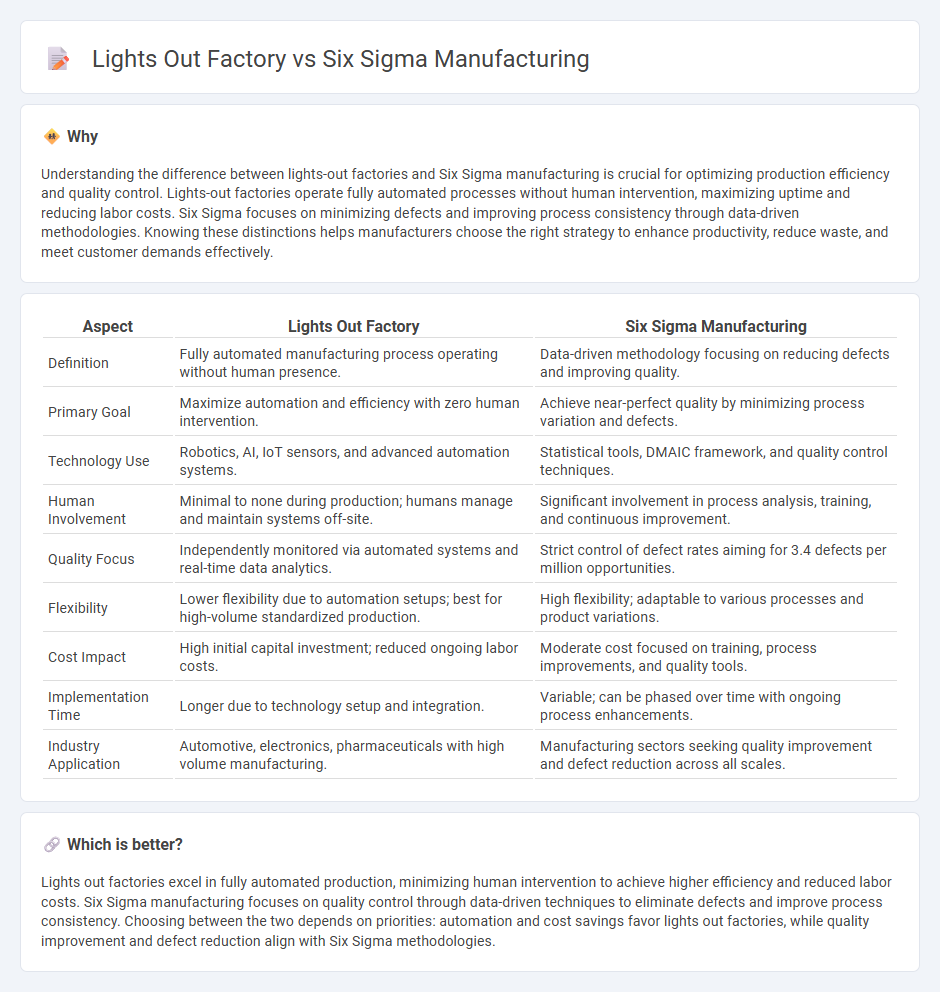
Lights out factories optimize manufacturing through fully automated, unmanned operations that reduce labor costs and increase production efficiency. Six Sigma manufacturing focuses on minimizing defects and variability by using data-driven methodologies to enhance quality control and process improvement. Explore the differences and benefits of these approaches to transform your manufacturing strategy.
Why it is important
Understanding the difference between lights-out factories and Six Sigma manufacturing is crucial for optimizing production efficiency and quality control. Lights-out factories operate fully automated processes without human intervention, maximizing uptime and reducing labor costs. Six Sigma focuses on minimizing defects and improving process consistency through data-driven methodologies. Knowing these distinctions helps manufacturers choose the right strategy to enhance productivity, reduce waste, and meet customer demands effectively.
Comparison Table
| Aspect | Lights Out Factory | Six Sigma Manufacturing |
|---|---|---|
| Definition | Fully automated manufacturing process operating without human presence. | Data-driven methodology focusing on reducing defects and improving quality. |
| Primary Goal | Maximize automation and efficiency with zero human intervention. | Achieve near-perfect quality by minimizing process variation and defects. |
| Technology Use | Robotics, AI, IoT sensors, and advanced automation systems. | Statistical tools, DMAIC framework, and quality control techniques. |
| Human Involvement | Minimal to none during production; humans manage and maintain systems off-site. | Significant involvement in process analysis, training, and continuous improvement. |
| Quality Focus | Independently monitored via automated systems and real-time data analytics. | Strict control of defect rates aiming for 3.4 defects per million opportunities. |
| Flexibility | Lower flexibility due to automation setups; best for high-volume standardized production. | High flexibility; adaptable to various processes and product variations. |
| Cost Impact | High initial capital investment; reduced ongoing labor costs. | Moderate cost focused on training, process improvements, and quality tools. |
| Implementation Time | Longer due to technology setup and integration. | Variable; can be phased over time with ongoing process enhancements. |
| Industry Application | Automotive, electronics, pharmaceuticals with high volume manufacturing. | Manufacturing sectors seeking quality improvement and defect reduction across all scales. |
Which is better?
Lights out factories excel in fully automated production, minimizing human intervention to achieve higher efficiency and reduced labor costs. Six Sigma manufacturing focuses on quality control through data-driven techniques to eliminate defects and improve process consistency. Choosing between the two depends on priorities: automation and cost savings favor lights out factories, while quality improvement and defect reduction align with Six Sigma methodologies.
Connection
Lights out factories utilize automation and minimal human intervention to achieve consistent, high-quality production, aligning closely with Six Sigma principles focused on reducing defects and process variability. Implementing Six Sigma methodologies enhances the precision and efficiency of lights out operations by systematically identifying and eliminating errors. This integration leads to optimized manufacturing processes with improved product quality, reduced downtime, and increased cost savings.
Key Terms
Six Sigma Manufacturing:
Six Sigma manufacturing emphasizes reducing defects and variability through data-driven methodologies, aiming for near-perfect quality and process efficiency by utilizing DMAIC (Define, Measure, Analyze, Improve, Control) frameworks. It relies heavily on statistical analysis and continuous improvement to minimize waste and optimize production workflows. Explore how Six Sigma strategies can transform your manufacturing operations for superior performance and quality.
DMAIC
Six Sigma manufacturing leverages the DMAIC (Define, Measure, Analyze, Improve, Control) methodology to systematically reduce defects and improve process efficiency, emphasizing data-driven decision-making and continuous quality improvement. In contrast, a Lights Out Factory operates with full automation, minimizing human intervention and relying on advanced robotics and AI to maintain consistent production with minimal downtime. Explore the intricacies of DMAIC in both environments to optimize operational excellence.
Defect Rate (DPMO)
Six Sigma manufacturing aims to minimize Defect Rate measured in Defects Per Million Opportunities (DPMO) by systematically reducing variability and improving process control to achieve near-perfect quality levels. Lights out factories rely heavily on automation and robotics to operate without human intervention, significantly decreasing human errors and driving down DPMO by ensuring consistent production quality. Explore the distinctions between these approaches to understand how each strategy impacts defect reduction and operational efficiency.
Source and External Links
Guide to Six Sigma Process for Manufacturers - MANTEC - Six Sigma in manufacturing applies the DMAIC methodology (Define, Measure, Analyze, Improve, Control) to increase throughput, improve product quality, and reduce production defects and process errors by data-driven root cause identification and elimination.
Six Sigma in Manufacturing - Siemens - Six Sigma was developed by Motorola in the 1980s and focuses on reducing variation in manufacturing processes to minimize defects, lower costs, and enhance customer satisfaction, often in conjunction with lean manufacturing principles.
Six Sigma - Wikipedia - Six Sigma originated from statistical quality control aiming for near-perfect manufacturing output with defect levels below 3.4 per million opportunities by maintaining process variations within six standard deviations from the mean.
 dowidth.com
dowidth.com